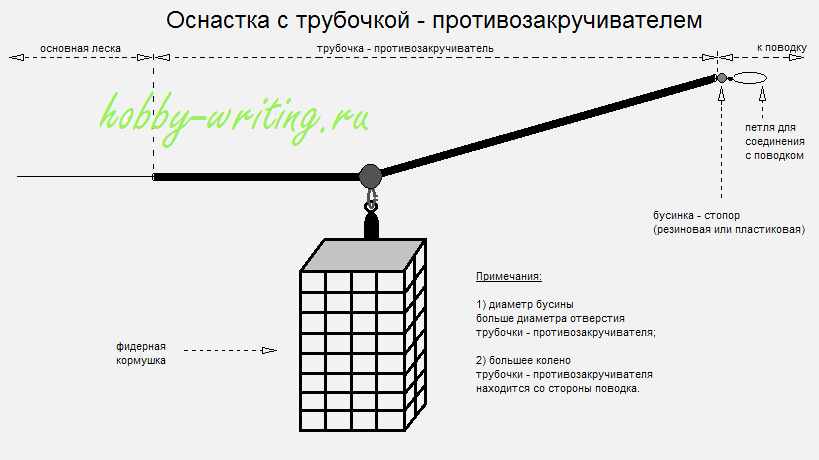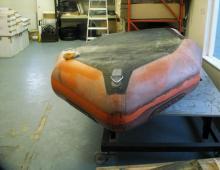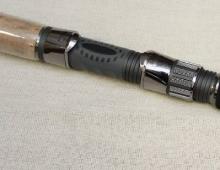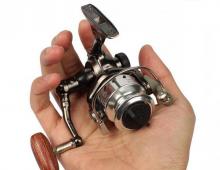Types of feeder equipment
In addition to a specialized rod and feeders, feeder fishing uses such an important element as feeder equipment. Realizing the importance of this element, I decided to open a separate column in which a number of thematic articles will be published.
In reality, there are a large number of varieties of equipment for catching fish on a feeder, but almost all of them are based on several basic rigs.
Since this article is introductory, I will try to describe in it the main types of equipment used for fishing on the feeder.
In general, feeder equipment is nothing more than a feeder assembly connected on the main line or on a separate piece of line, which is the supporting structure to which the feeder and leash are attached.
Thanks to a properly made feeder rig, the transfer of fish bites to the quiver-type of the feeder rod is ensured. In addition, it allows you to avoid or minimize the entanglement of such elements of the feeder gear as the feeder, leader and main line.
feeder equipment
The main types of equipment for feeder fishing can be divided into the following groups:
Below we will consider in more detail each of the listed snap-ins, with the exception of method mounting, which will be discussed in a separate article in the future.
1. Feeder equipment with anti-twist.
This is one of the simplest rigs in terms of design. For its manufacture, it is enough to perform a number of elementary steps:
Buy a plastic tube in the store - an anti-twist;
Pass the main fishing line on the pond into the hole of the tube;
Thread a rubber or plastic bead onto the main line that acts as a stopper;
Tie a leash to the main line;
Attach a tube to the carabiner - an anti-twist feeder.
The ease of manufacture and the minimal chance of tangling have made this rig very popular among beginner feeders. However, it has a number of significant drawbacks, such as visibility, low sensitivity and bulkiness. In some cases, due to contamination of the tube opening, low sensitivity can develop into its complete absence.

2. Feeder equipment "inline"
This rig is also easy to manufacture, but there are a number of details that are critical to its effectiveness:
Mandatory presence of a twist, the length of which must exceed the length of the feeder and in practice is at least 10 - 15 cm;
When fishing in reservoirs with bottom silt, it is necessary to mount the feeder on the outlet, respectively, the length of the twist also needs to be increased.
The principle of operation of the feeder equipment is simple: the main fishing line or shock leader is threaded into the hole of the feeder swivel, then a rubber or plastic bead is mounted - a stopper, and a loop is knitted behind it to connect to the leash.
The feeder in the inline rig moves freely along the main line, hence the second name - sliding installation.
In the case of using a plastic bead, either a piece of rubber cambric or a silicone stopper must be put between the latter and the loop for connecting to the leash to prevent damage to the knot at the base of the loop.
This rig is the only one allowed in international feeder fishing competitions. The reason for this is the possibility of a free descent of the feeder from the fishing line in the event of a break in gear. This circumstance allows the fish that has broken the tackle to get rid of the feeder.
In terms of sensitivity, in my opinion, inline loses to loop and fixed rigs when biting fish towards the shore.

3. Feeder equipment "Symmetrical loop"
This equipment is described in many sources, but almost everywhere there is no information on the optimal conditions for its use. Only a few feederists recommend using it when fishing with a picker. Perhaps the rarity of the use of a symmetrical loop is due to the lower sensitivity compared to other installations. It seems that in the early days of feeder loop rigs, it was popular, but now the asymmetric loop has taken its place in the sun.
I will list some features in the manufacture of a symmetrical loop:
The outlet for connection with the leash is made in the form of a twist, the length of which must be greater than the length of the feeder;
The arms of a symmetrical loop are of equal length and are about 15-20cm;
The feeder moves freely along one of the arms of the loop.
On my feeder fishing, I almost never use this rig.

4. Feeder equipment "Asymmetric loop"
This rig, in my opinion, is a successful modification of the symmetrical loop. In asymmetry, one of the loop arms is longer than the other, which provides excellent sensitivity when using this equipment.
The difference in the length of the shoulders forms the so-called "overhang" for the feeder. The length of the "hanging" ranges from 0.5 cm to 3 cm, and the length of the loop itself is from 15 to 50 cm. The indicated dimensions depend on the conditions for using the equipment, the activity of the fish and the tactics of fishing. These factors will be discussed in more detail in a separate article.
An asymmetric loop is made, as well as a symmetrical loop, based on a monofilament or fluorocarbon fishing line (diameter from 0.28 to 0.35 mm)
The length of the branch - twisting to connect the leash must exceed the total length of the "overhang" and the feeder.
The asymmetric loop on my fishing is the main rig for fishing in the current.

5. Feeder equipment "Paternoster"
The indicated installation is knitted using a piece of ordinary monofilament or fluorocarbon fishing line (approximate diameter from 0.28 to 0.35 mm). The paternoster consists of two branches, a leash is tied to the longer of them, and a feeder is mounted to the short one. The length of the lead under the leash is greater than the total length of the feeder and the lead under it. For the manufacture of the paternoster, a fishing line of two diameters can be used, and a thinner fishing line is used for the outlet for the feeder. In the event that when playing a fish, the feeder is stuck in a snag or caught on the edge, the angler has a chance to save the trophy, limiting himself to a break in the branch with the feeder.

6. Feeder equipment "Gardner loop"
This installation is a modernization of the paternoster and differs from it in two factors:
It is knitted on the main braided or monofilament fishing line;
A loop outlet is used for the feeder.
The advantages of the Gardner loop include simplicity and speed of manufacture, the ability to quickly change feeders, and good sensitivity.
As a rule, the Gardner loop is used on rivers, as can be learned from various sources. However, on my feeder fishing, I most often use this type of feeder equipment on stagnant water bodies.
When making Gardner's equipment, it must be taken into account that the length of the outlet for connection to the leash must be greater than the total length of the loop and the feeder.

7. Feeder equipment "Helicopter"
This name of the equipment is due to the way the leash is attached to it, which can freely spin around the main fishing line, like the blades of a helicopter. This installation is effective when catching active fish in the current, under the influence of which the leash with bait rises above the bottom. This circumstance expands the horizon of catching fish and allows you to catch it at a certain distance from the bottom. By adjusting the length and diameter of the leader, as well as the size of the hooks, you can achieve the effect of simulating a slowly lowering bait, increasing the naturalness of its presentation. This naturalness, in turn, has a positive effect on the bite. Manufacturing technology and recommended dimensions are shown in the figure.

With this, I propose to complete the review of feeder equipment. I hope that the information given in the article will help you better understand the details of feeder fishing.
As I wrote at the beginning of the article, on the pages of my blog I will repeatedly return to the topic of making and using equipment for fishing on the feeder.
No tail, no scales!
Copyright: Ivanitsky Vitaliy, 2013
Material taken from the site:



